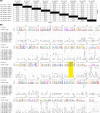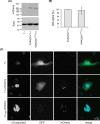Characterization of the catalytic center of the Ebola virus L polymerase
- PMID: 28991917
- PMCID: PMC5648267
- DOI: 10.1371/journal.pntd.0005996
Characterization of the catalytic center of the Ebola virus L polymerase
Abstract
Background: Ebola virus (EBOV) causes a severe hemorrhagic fever in humans and non-human primates. While no licensed therapeutics are available, recently there has been tremendous progress in developing antivirals. Targeting the ribonucleoprotein complex (RNP) proteins, which facilitate genome replication and transcription, and particularly the polymerase L, is a promising antiviral approach since these processes are essential for the virus life cycle. However, until now little is known about L in terms of its structure and function, and in particular the catalytic center of the RNA-dependent RNA polymerase (RdRp) of L, which is one of the most promising molecular targets, has never been experimentally characterized.
Methodology/principal findings: Using multiple sequence alignments with other negative sense single-stranded RNA viruses we identified the putative catalytic center of the EBOV RdRp. An L protein with mutations in this center was then generated and characterized using various life cycle modelling systems. These systems are based on minigenomes, i.e. miniature versions of the viral genome, in which the viral genes are exchanged against a reporter gene. When such minigenomes are coexpressed with RNP proteins in mammalian cells, the RNP proteins recognize them as authentic templates for replication and transcription, resulting in reporter activity reflecting these processes. Replication-competent minigenome systems indicated that our L catalytic domain mutant was impaired in genome replication and/or transcription, and by using replication-deficient minigenome systems, as well as a novel RT-qPCR-based genome replication assay, we showed that it indeed no longer supported either of these processes. However, it still showed similar expression to wild-type L, and retained its ability to be incorporated into inclusion bodies, which are the sites of EBOV genome replication.
Conclusions/significance: We have experimentally defined the catalytic center of the EBOV RdRp, and thus a promising antiviral target regulating an essential aspect of the EBOV life cycle.
Conflict of interest statement
The authors have declared that no competing interests exist.
Figures



References
-
- Feldmann H, Geisbert TW (2011) Ebola haemorrhagic fever. Lancet 377: 849–862. doi: 10.1016/S0140-6736(10)60667-8 - DOI - PMC - PubMed
-
- Team WHOER, Agua-Agum J, Allegranzi B, Ariyarajah A, Aylward R, et al. (2016) After Ebola in West Africa—Unpredictable Risks, Preventable Epidemics. N Engl J Med 375: 587–596. doi: 10.1056/NEJMsr1513109 - DOI - PubMed
-
- Mire CE, Geisbert TW, Feldmann H, Marzi A (2016) Ebola virus vaccines—reality or fiction? Expert Rev Vaccines 15: 1421–1430. doi: 10.1080/14760584.2016.1178068 - DOI - PMC - PubMed
-
- Fearns R, Deval J (2016) New antiviral approaches for respiratory syncytial virus and other mononegaviruses: Inhibiting the RNA polymerase. Antiviral Res 134: 63–76. doi: 10.1016/j.antiviral.2016.08.006 - DOI - PubMed
-
- Martin B, Canard B, Decroly E (2017) Filovirus proteins for antiviral drug discovery: Structure/function bases of the replication cycle. Antiviral Res 141: 48–61. doi: 10.1016/j.antiviral.2017.02.004 - DOI - PubMed
MeSH terms
Substances
LinkOut - more resources
Full Text Sources
Other Literature Sources
Medical
Research Materials

